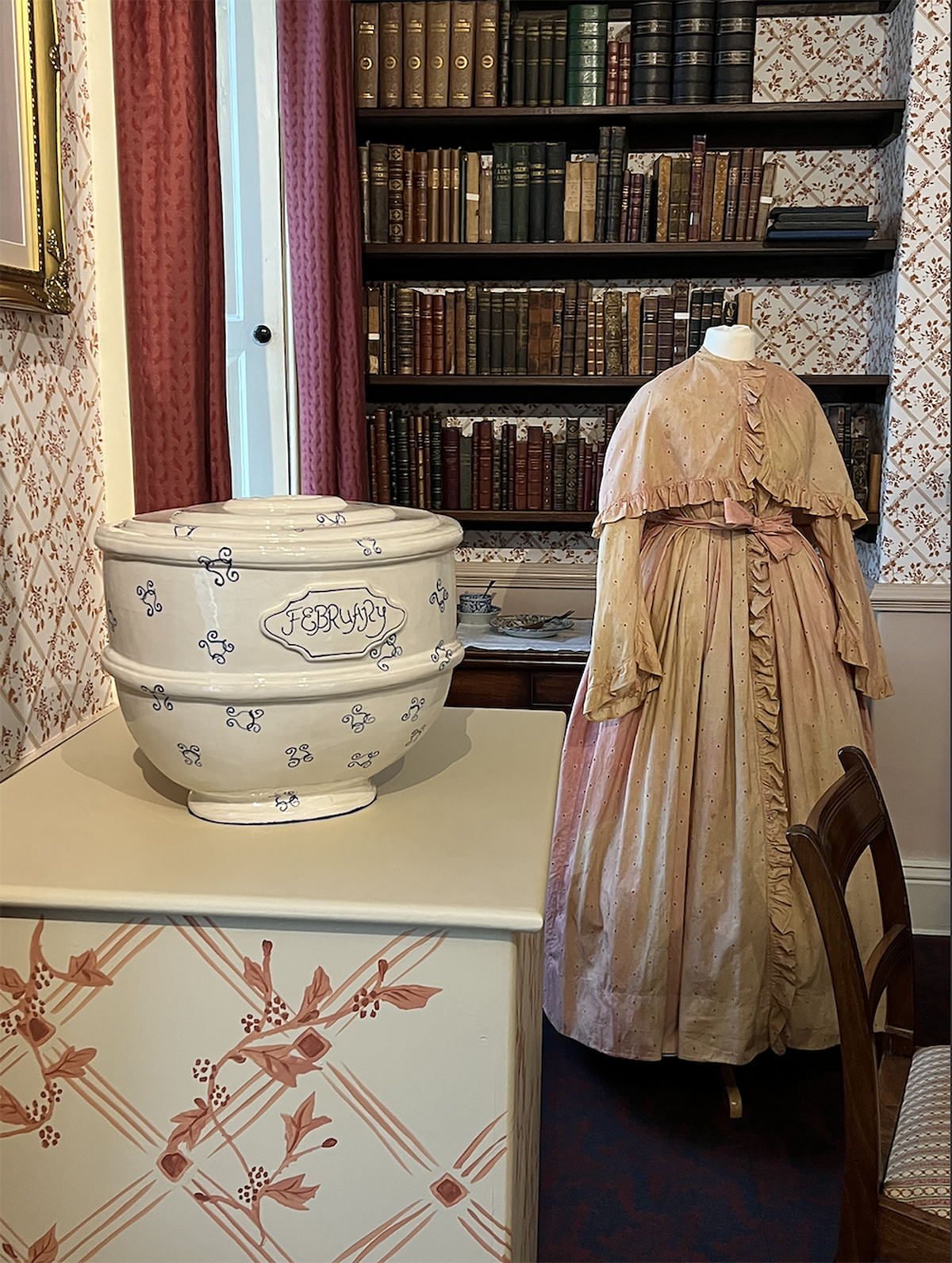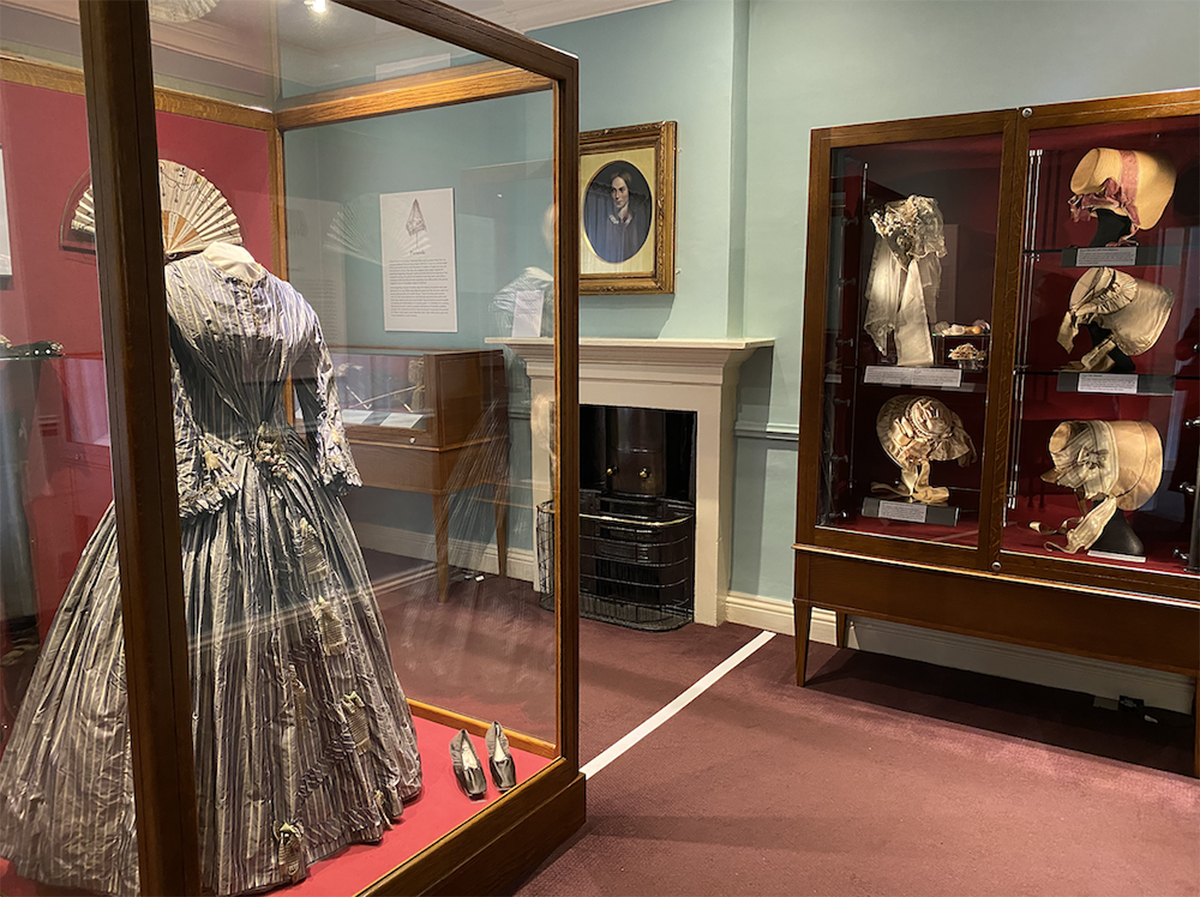Dress objects are on display in almost every room in the Brontë Parsonage Museum. Following the signposted one-way route around the moor-side house in Haworth, West Yorkshire, one frequently encounters the sartorial ghosts of Charlotte, Emily, Anne, Branwell, and Patrick Brontë. Scattered among furniture once owned by the family, clothes play an impactful role in the recreation and embodiment of the former home of the Brontës.1 However, although a spread in the Illustrated London News (26 March 1955) reveals that clothing worn by the family was collected by the Brontë Society and displayed in the Brontë Parsonage Museum since the 1950s, the museum has not, until now, held an exhibition exclusively dedicated to the dress of the writers to whom it acts as a shrine.2 ‘Defying Expectations: Inside Charlotte Brontë’s Wardrobe’ (2 February 2022–1 January 2023) is, therefore, the first exhibition to explore the sartorial life of one of the Brontës through a selection of garments and accessories from what survives of Charlotte Brontë’s wardrobe. Co-curated by the Brontë Parsonage Museum and dress historian Dr Eleanor Houghton, the exhibition uses dress objects to ‘boldly challenge’ preconceptions about the identity and experiences of Brontë — a thesis seemingly in vogue as the central narrative of recent exhibitions commemorating Victorian novelists and literary figures.3
Museums and heritage sites have a long history of interpreting clothing as biographical relics that can enrich our knowledge of well-known Victorian figures. Most recently, dress objects have featured in exhibitions such as ‘Technicolour Dickens: The Living Image of Charles Dickens’ (Charles Dickens Museum, 2020–21), ‘Victoria: Woman and Crown’ (Kensington Palace, 2019–20), and the Florence Nightingale Museum’s permanent display ‘Portraits of Florence’, to name just a few. ‘Defying Expectations’ is a further development in what has become a popular approach to curating eminent Victorians through dress.
In writers’ or literary house museums, the display of ‘intimate personal belongings’, as historian Sophie Forgan suggests, ‘acts to provide both an essential humanising effect and authentication of the site’s former resident’.4 The role of dress in writers’ house museums is therefore intrinsic and, arguably, imperative to this process. Unlike any other museum object, items of clothing are often imbued with marks of wear that offer insight into the physicality of individuals, such as height, shape, stance, and gesture, which can be represented through the modification of mannequins. Moreover, individual dress objects with known provenance can represent notable events, milestones, or incidents in a person’s life, while the rare survival of a complete wardrobe may narrate an entire biography.5 ‘Defying Expectations’ provides a partial view of Charlotte Brontë’s biography by displaying objects representative of key moments in her life. It dissociates her from narratives of writing in order to reimagine Brontë, adopting dress material culture as a medium to do so.
Dress objects on display as part of the exhibition are encountered within several rooms in the Brontë Parsonage Museum: the dining room, Charlotte Brontë’s bedroom, and the museum’s temporary exhibition space on its ground floor. The three rooms vary in their display techniques. In the dining room a dressed mannequin stands within a fully furnished period room, while the others feel more like traditional museum galleries. As a result of the dispersal of the dress objects across the parsonage, the exhibition feels a little disconnected, though the integration of this material into the existing displays and fabric of the building is seamless.
Visitors first encounter Charlotte Brontë’s dress in the dining room (Fig. 1). Furnished with items dating from the period in which all three sisters were alive, the room was the centre of parsonage life for the Brontë siblings. For pilgrims to Brontë country, it is this room, where the Brontë sisters imagined and wrote their stories, and where Emily Brontë passed away in 1848, that is perhaps the most sacred of all sites. Clothing has previously been exhibited in the dining room, including replica garments worn by the three actresses who played the sisters in the BBC’s To Walk Invisible (2016). In this new exhibition the display of Charlotte Brontë’s pink wrapping gown and matching cape (c. 1854), within the furnished surroundings in which it may have once been worn, produces an awe-inspiring and eerie encounter with both an historical environment and the long-dead individual who inhabited it. Headless and gestureless, it appears that the mannequin on which the dress is mounted is in no way intended to personify Brontë, or, in fact, act as a period-correct surrogate body. When curating dress, it is widely accepted that, in order to correctly revive and re-present historical clothing, custom-made display stands and the correct undergarments are required. As these help to recreate the stance and gestures typical of the periods in which garments were worn, they are ‘an absolutely integral part of the “look” of the time’.6 The omission of such curatorial methods risks presenting historical dress as ‘lifeless things devoid of meaning’.7 However, this is somewhat mitigated at the Brontë Parsonage Museum exhibition, where the dress is surrounded by a myriad of other ‘spirited things’, such as the dining table at which the sisters wrote, and its known provenance (such as its former contact with Brontë’s body) revives all 4 feet 10 inches of Brontë.8
While the dress evokes Brontë’s presence in the dining room, upstairs, in her former bedroom, pieces from her wardrobe are presented as sacred sartorial relics, relegating her to the past (Fig. 2). All cabinets in this room are permanent features and have, before now, showcased clothing worn by Brontë. The focal point of ‘Defying Expectations’ is a large central cabinet displaying a striped dress, which has never been exhibited before, along with a pair of gloves, shoes, stockings, and a fan. Surrounding this are four cabinets containing accessories (shawls, parasols, and bonnets); one style of dress per cabinet. These include objects marking significant relationships and events in Brontë’s life, such as the bonnet and veil she wore to her wedding to Arthur Bell Nicholls in 1854, and a fan she received as a gift from her close friend Ellen Nussey.
Throughout the room, object labels narrate the social biography of Brontë, revealing the events to which the items were worn and providing ‘unusual insight[s] into the impact that fame had upon Charlotte’s life’. The language used in the labels typifies the central theme of the exhibition, with keywords such as ‘conspicuous’, ‘expensive’, ‘elegant’, and ‘sumptuous’ positioning Brontë as an unusually active follower of Victorian fashion. Visitors not familiar with Victorian dress history may be forgiven for overlooking the ‘remarkable’ nature of Brontë’s clothes (the exhibition’s central argument), as similar garments are frequently presented in museum displays and exhibitions showcasing nineteenth-century fashion.9 Thus, the dress objects on display as part of ‘Defying Expectations’ may have benefited from further contextualization, such as insights into the contemporary monetary value of Brontë’s dress, or a contrasting view of the dress and sartorial experiences of Brontë’s working-class acquaintances and neighbours.
In the exhibition’s white cube-like final exhibition space, the manner in which visitors encounter Brontë’s wardrobe shifts once again. Here, only the fragmentary remains of her clothes are on display (Fig. 3). In the field of dress history, scholars often rely on such objects to determine and/or defy our expectations of the dress of marginalized groups or clothing worn pre-1700. The Brontë Society’s collection includes a great number of fragments of dress worn by Charlotte Brontë, many of which are the result of twentieth-century Brontë relic hunters deconstructing garments into fabric mementos. The display panels explain this, reminding visitors about the afterlives of Brontë and her material remains. Thus, it seems that anthropologists Arjun Appadurai’s and Igor Kopytoff’s notions of the biographies and social lives of objects — that is, the study of the various ways in which objects are produced, used, exchanged, and/or repurposed over the course of their existence, and what this may reveal about how cultures and individuals attribute meaning and value to inanimate things — have influenced the curatorial interventions at play here.10
A pair of moccasins, originating from Canada, exemplifies the exhibition’s thesis of ‘remarkable’ dress more so than any other object on display. Unlike the dress that was commonly owned and worn by Western women during the nineteenth century, the contextual ephemera relating to this object (letters and photographs) reveal Brontë’s international network. Brontë received the shoes, along with a beaded bag, as a gift from her New York-based publishers following the publication of Jane Eyre (1847). Throughout the exhibition, it is often the circumstances in which she acquired, wore, and/or lost items of dress, arguably more than the dress objects themselves, that truly defy twenty-first century expectations of Brontë.
As the first temporary exhibition entirely comprised of the surviving dress of one of the Brontë sisters, ‘Defying Expectations’ demonstrates how dress objects can play a major role in the curation of literary house museums. As such, the exhibition suggests new ways in which these museums might approach the biographies of some of our favourite writers and the kind of material culture they choose to collect, display, and interpret.
Notes
- Both authentic and replica dress objects are on display throughout the house as permanent features. These include a pair of glasses, hat, and gloves in Mr [Patrick] Brontë’s study, a nightshirt said to have been worn by Charlotte Brontë draped on a chair in Patrick Brontë’s bedroom, a bonnet and shawl in the children’s study, and various male garments scattered on the floor in Branwell’s studio. [^]
- See ‘The Charlotte Brontë Centenary: Her Life at Haworth Recalled’, Illustrated London News, 26 March 1955, p. 567. [^]
- These recent exhibitions and curatorial projects include Nuneaton Museums and Library and the Herbert Museum & Art Gallery’s project ‘Exploring Eliot’ (2019), which interpreted garments once owned and worn by George Eliot as evidence of Eliot’s affluence and participation in contemporary fashions. Likewise, the Charles Dickens Museum’s ‘Technicolour Dickens: The Living Image of Charles Dickens’ (2020–21) revealed a ‘Dickens like you have never seen him before’ with an exhibition that included a waistcoat worn by the famous author. [^]
- Sophie Forgan, ‘“Keepers of the Flame”: Biography, Science and Personality in the Museum’, in Museums and Biographies: Stories, Objects, Identities, ed. by Kate Hill (Woodbridge: Boydell Press, 2012), pp. 247–63 (p. 257). [^]
- See Amy de la Haye, Lou Taylor, and Eleanor Thompson, A Family of Fashion: The Messels: Six Generations of Dress (London: Philip Wilson Publishers, 2005); and Jeffrey Horsley, ‘Exhibiting a Life: Gluck and the Biographic Object’, in Gluck: Art and Identity, ed. by Amy de la Haye and Martin Pel (New Haven: Yale University Press, 2017), pp. 134–51. [^]
- Lou Taylor, The Study of Dress History (Manchester: Manchester University Press, 2002), p. 29. [^]
- Mary M. Brooks, ‘Reflecting Absence and Presence: Displaying Dress of Known Individuals’, in Refashioning and Redress: Conserving and Displaying Dress, ed. by Mary M. Brooks and Dinah D. Eastop (Los Angeles: Getty Conservation Institute, 2016), pp. 19–32 (p. 20). [^]
- Alison Booth, ‘Houses and Things: Literary House Museums as Collective Biography’, in Museums and Biographies, ed. by Hill, pp. 231–46 (p. 236). [^]
- This text is taken from an object label accompanying the striped dress on display in the central cabinet of Charlotte Brontë’s former bedroom. [^]
- See Arjun Appadurai, ‘Introduction: Commodities and the Politics of Value’, in The Social Life of Things: Commodities in Cultural Perspective, ed. by Arjun Appadurai (Cambridge: Cambridge University Press, 1986), pp. 3–63; and Igor Kopytoff, ‘The Cultural Biography of Things: Commoditization as Process’, in The Social Life of Things, ed. by Appadurai, pp. 64–91. [^]



